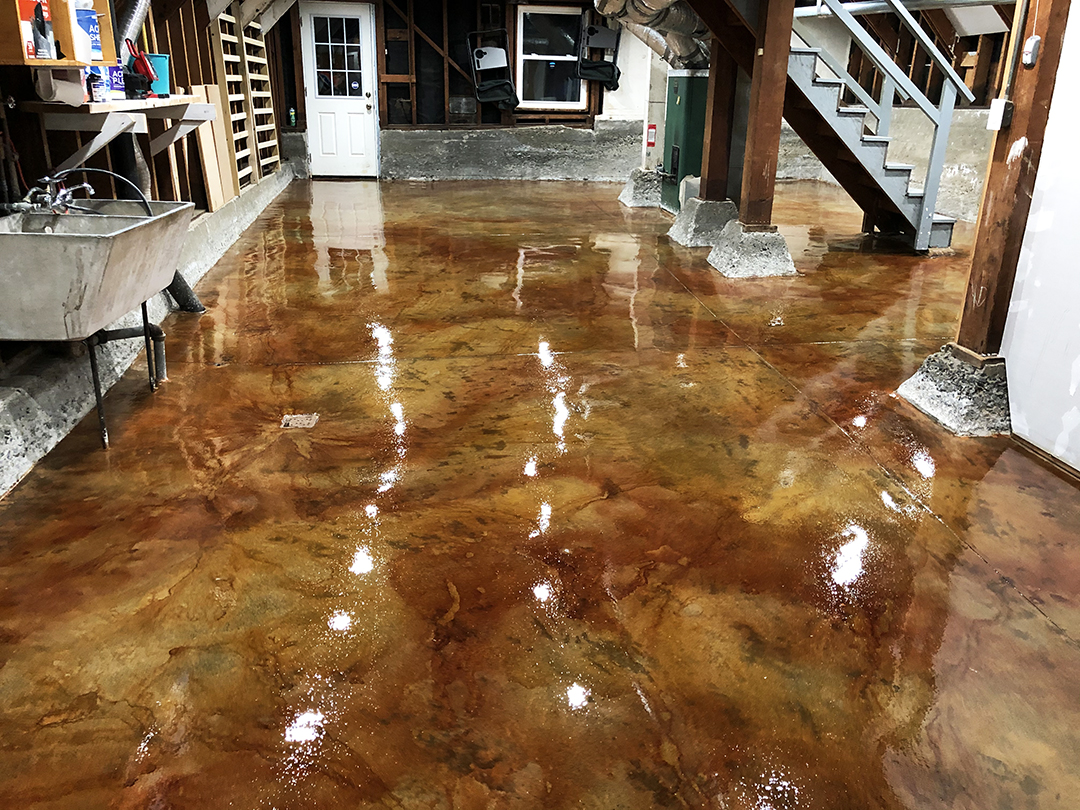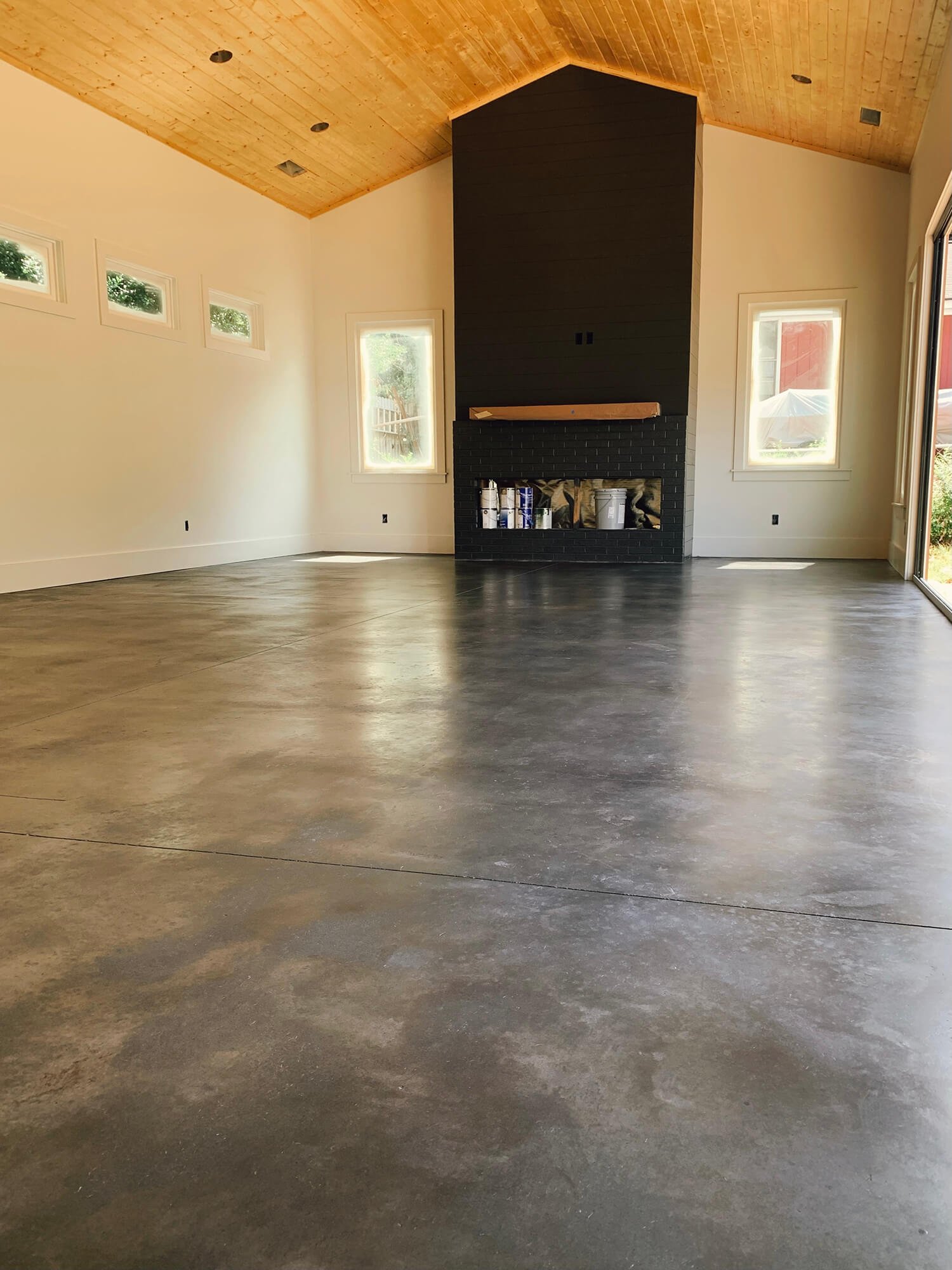Reasons a stained concrete company can enhance your property
Understanding the Various Kinds of Stained Concrete for Your Following Job
Stained concrete deals various choices that accommodate different visual and functional requirements. Each type provides distinctive characteristics that affect the last appearance and sturdiness of the surface. Recognizing these differences is crucial for anyone intending a task. From abundant, chemical responses of acid-based stains to the vibrant harmony of solid shade stains, the choices can substantially influence the outcome. What factors should one think about when picking the optimal tarnish for their certain demands?
Summary of Stained Concrete
Stained concrete functions as a flexible floor covering option that can boost the visual appeal of numerous spaces. This method involves using a tinting representative to the surface area of existing concrete, enabling a wide range of design possibilities. Stained concrete is preferred in both household and business atmospheres, providing a sturdy and low-maintenance solution that can mimic the appearance of all-natural materials like rock or ceramic tile.
The discoloration procedure can be performed making use of water-based or solvent-based products, each providing unique visual results. The last look is influenced by variables such as the original concrete surface, the sort of stain utilized, and the application technique. Stained concrete not only enhances exterior and interiors yet also promotes sustainability by rejuvenating existing concrete structures. Consequently, it has actually obtained traction amongst homeowners and developers seeking both performance and style in their flooring options.
Acid-Based Stains: Features and Advantages

Distinct Shade Variants
Concrete surface areas can transform considerably with the application of acid-based stains, which provide a rich palette of distinct color variants. These stains penetrate the concrete, responding chemically to produce lively earth tones that range from deep browns and reds to soft eco-friendlies and blues. The resulting tones are commonly variegated, creating an all-natural, marble-like look that improves the concrete's character. Each application yields distinct outcomes due to variations in the concrete's structure and the discoloration strategy used, making every task special. Furthermore, acid-based stains can be layered or combined with other strategies to develop customized styles, permitting personal expression. This adaptability makes acid-based stains a popular option for both residential and industrial applications.
Chain Reaction Explained
While many aspects add to the performance of acid-based stains, the underlying chain reaction play a crucial duty in their one-of-a-kind attributes and advantages. These stains mostly include water, acid, and metal salts. When used to concrete, the acid reacts with the calcium hydroxide in the concrete, producing a chemical improvement that leads to irreversible shade modifications. The metal salts pass through the surface area and bond with the concrete, enabling a wide variety of tones and tones. This reaction not only boosts visual allure however additionally offers resilience, making the color resistant to fading and wear. Furthermore, acid-based stains can produce a variegated finish that resembles all-natural rock, further boosting their appeal for ornamental concrete applications.
Surface Area Preparation Value
Attaining optimal results with acid-based stains depends upon extensive surface area prep work. This crucial step assurances that the concrete surface area is tidy, devoid of impurities, and effectively profiled for excellent discolor absorption. Any type of existing sealants, dust, or oils can impede the chain reaction that creates the wanted shade and finish, bring about irregular or uneven results.
Prior to using the tarnish, the concrete ought to be mechanically cleansed or pressure cleaned, complied with by a detailed assessment for cracks or flaws that might require repair service. In addition, validating the surface area is adequately dried will certainly improve stain adherence. By prioritizing these primary steps, the durability and vibrancy of acid-based stains can be substantially enhanced, leading to a much more aesthetically pleasing and sturdy surface.
Water-Based Stains: Functions and Benefits

Water-based stains penetrate the concrete, using a much more transparent finish that highlights the natural texture and variations of the surface area below. They are available in a wide variety of shades, enabling innovative adaptability in design. In addition, water-based stains are simpler to tidy up, calling for only water and soap, which streamlines the application process.
Their fast drying time boosts efficiency, making them a functional choice for both do it yourself fanatics and specialists. In general, water-based stains give an appealing combination of visual convenience and straightforward homes, making them a popular choice for concrete improvement projects.
Solid Color Stains: Vivid Options for a Strong Appearance
Solid shade stains offer a reliable option for those looking for to develop a strong and vibrant aesthetic on concrete surfaces. These stains give an uniform coloration that can drastically improve the aesthetic allure of floorings, patio areas, and driveways. Available in a broad range of shades, solid color stains permit imaginative expression, accommodating various design choices.
One of the key benefits of solid shade stains is their capability to conceal blemishes, providing a fresh and refined look to aging concrete - stained concrete floors. Furthermore, their formulation generally consists of UV-resistant buildings, making sure durability and shade retention also in severe weather
Application is straightforward, calling for very little preparation of the concrete surface. Once used, strong color stains can be sealed for included defense and shine, further boosting their aesthetic high quality. With their vibrant alternatives, solid color stains are an exceptional selection for those aiming for an impactful and natural layout.
Semi-Transparent Stains: Attaining Deepness and Measurement
Semi-transparent stains supply an unique approach to boosting concrete surface areas by giving depth and measurement through various color options. Recognizing the application methods is crucial for attaining the preferred result, while correct maintenance practices assure long life. This section will certainly explore these essential elements to make best use of the benefits of semi-transparent discoloration.
Shade Options Available
A wide array of color options exists for semi-transparent stains, allowing home owners and designers to enhance the natural appeal of concrete surfaces. These stains are available in a selection of hues, from earthy tones like browns and terracottas to vibrant colors such as blues and environment-friendlies. The semi-transparent nature of these stains enables the underlying concrete to show with, creating a distinct navigate to these guys depth and dimension that can enhance different style aesthetic appeals. In addition, integrating different shades can create custom-made tones, enabling a tailored appearance for each task. This flexibility makes semi-transparent stains a prominent option for both interior and exterior applications, as they can harmonize with surrounding components while including aesthetic interest to simple concrete.
Application Methods Discussed
To accomplish the desired depth and dimension with semi-transparent stains, appropriate application techniques are vital. Initially, surface prep work is critical; the concrete should be tidy and devoid of any kind of impurities. This commonly involves power cleaning and repairing any type of splits. Next, selecting the best applicator, such as a sprayer, roller, or brush, can influence the last look. Sprayers permit for a more also application, while rollers can assist accomplish structure. It is essential to use the stain in slim, even layers, permitting each layer to dry prior to adding another. Manipulating the application technique, such as differing pressure or using different devices, can produce one-of-a-kind impacts. Finally, securing the stained surface enhances the vibrancy of the shades while providing protection.
Upkeep Best Practices
Regular maintenance is essential for protecting the charm and integrity of surface areas treated with semi-transparent stains. To keep these surfaces, regular cleansing is crucial. Using a pH-neutral cleaner and a soft-bristle broom will certainly help eliminate dust and debris without damaging the discolor. It is suggested to prevent severe chemicals, as they can break down the stain's appearance. Additionally, periodic resealing each to 3 years can shield versus wear and fading. This procedure entails cleaning up the surface thoroughly and using a suitable this website sealer developed for stained concrete. Property owners ought to additionally check for any indicators of discoloration or damage and address these issues without delay to assure lasting vibrancy and longevity. Following these finest practices will certainly improve the total life-span of semi-transparent stained surfaces.
Results and Techniques: Personalizing Your Stained Concrete
Customizing stained concrete entails an array of techniques that boost both appearances and capability. Amongst these techniques, layering various tarnish shades can create depth and complexity, permitting one-of-a-kind visual impacts. Methods such as acid staining offer a variegated look, while water-based stains supply an extra uniform look.
Furthermore, incorporating decorative patterns, such as stenciling or inscription, can even more personalize the surface area, including detailed designs that deal with specific tastes. Texturing the concrete, whether via stamping or mop finishes, introduces responsive components that not just improve grip but also boost aesthetic interest.
Furthermore, using sealers can intensify the color vibrancy and supply security versus wear. Customization techniques expand past simple color; they can change a typical concrete piece into a spectacular prime focus, making it appropriate for both household and industrial spaces. Through careful selection of effects and techniques, stained concrete can accomplish a truly customized look.
Maintenance and Durability of Stained Surfaces
Stained concrete surfaces are recognized for their sturdiness and visual appeal, maintaining their integrity is important for guaranteeing longevity. Regular cleaning is vital; sweeping and mopping with a pH-neutral cleaner assists prevent dust buildup and staining. In addition, using a sealant every few years can secure the surface area from dampness, chemicals, and UV damages, therefore boosting its lifespan.
It is likewise important to attend to any cracks or chips quickly. Small repair services can minimize additional degeneration, preserving the aesthetic and structural high quality of the surface area. For outside stained concrete, seasonal upkeep, such as getting rid of snow and ice, is essential to avoid surface damages from freeze-thaw cycles.
Frequently Asked Inquiries
Can I Discolor Existing Concrete Surfaces or Only New Ones?
The inquiry of whether existing concrete surface areas can be stained occurs frequently. It is without a doubt feasible to stain both brand-new and old concrete, supplied the surface area is appropriately ready and without pollutants for perfect adhesion.
How much time Does the Discoloration Process Typically Take?
The staining procedure commonly takes one to 3 days, depending on factors such as surface area prep work, type of stain, and climate condition. local stained concrete. Healing time might extend beyond preliminary application, affecting the total duration significantly
Is Stained Concrete Safe for Outdoor Use?
Stained concrete is generally risk-free for outdoor use, gave it is appropriately secured. This sealing shields versus moisture and UV damage, ensuring resilience and safety and security, while likewise improving the visual charm of outside spaces.
Can I Apply Numerous Spot Layers for Various Impacts?
Using numerous tarnish layers can accomplish diverse impacts on stained concrete. However, it is important to guarantee compatibility between stains and enable appropriate drying out time in between applications to avoid unintended reactions or discoloration.
Exist Any Type Of Shade Limitations for Stained Concrete?
Color limitations for stained concrete mainly depend upon the kind of stain utilized, with water-based stains using a wider scheme contrasted to acid-based stains. stained concrete. However, achieving lively colors may call for get more careful selection and application strategies